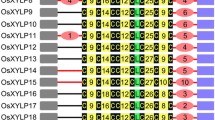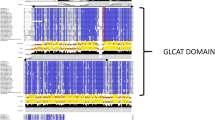Abstract
Arabinogalactan-proteins (AGPs) are present on the surface of all plant cells. AtAGP17, 18 and 19 comprise the lysine-rich AGP subfamily in Arabidopsis and consist of an N-terminal signal peptide, a classical AGP domain interrupted by a small Lys-rich region and a C-terminal glycosylphosphatidylinositol (GPI) anchor addition sequence. Organ- and tissue-specific expression patterns and subcellular localization of AtAGP18 were studied and compared to other Lys-rich AGPs. AtAGP18 was highly expressed in roots, flowers and stems and weakly expressed in seedlings and rosettes. High AtAGP18 promoter activity was closely associated with vascular tissues and high in young organs as well as styles. Microarray and massively parallel signature sequencing (MPSS) data were also examined and showed largely consistent transcription profiles of AtAGP18. On the protein level, AtAGP18 was most abundant in roots and flowers, moderate in stems, seedlings and siliques and low in rosette leaves. Furthermore, AtAGP18 was localized to the plasma membrane and to Hechtian strands, following plasmolysis of tobacco cultured cells expressing a green fluorescence protein (GFP)–AtAGP18 fusion protein. Localization of AtAGP18 on the plasma membrane was further confirmed by biochemical two-phase fractionation and Western blotting. These expression and localization data further our understanding of AtAGP18 and provide a molecular basis to approach and decipher its function.





Similar content being viewed by others
Abbreviations
- ABA:
-
Abscisic acid
- AGP:
-
Arabinogalactan-protein
- GFP:
-
Green fluorescence protein
- GPI:
-
Glycosylphosphatidylinositol
- GUS:
-
β-Glucuronidase
- HRGP:
-
Hydroxyproline-rich glycoprotein
- MPSS:
-
Massively parallel signature sequencing
- PM:
-
Plasma membrane
- TPM:
-
Transcripts per million
References
Acosta-Garcia G, Vielle-Calzada J-P (2004) A classical arabinogalactan protein is essential for the initiation of female gametogenesis in Arabidopsis. Plant Cell 16:2614–2628
Alonso JM, Stepanova AN, Leisse TJ, Kim CJ, Chen H, Shinn P, Stevenson DK, Zimmerman J, Barajas P, Cheuk R, Gadrinab C, Heller C, Jeske A, Koesema E, Meyers CC, Parker H, Prednis L, Ansari Y, Choy N, Deen H, Geralt M, Hazari N, Hom E, Karnes M, Mulholland C, Ndubaku R, Schmidt I, Guzman P, Aguilar-Henonin L, Schmid M, Weigel D, Carter DE, Marchand T, Risseeuw E, Brogden D, Zeko A, Crosby WL, Berry CC, Ecker JR (2003) Genome-wide insertional mutagenesis of Arabidopsis thaliana. Science 301:653–657
Campanella JJ, Bitincka L, Smalley J (2003) MatGAT: An application that generates similarity/identity matrices using protein or DNA sequences. BMC Bioinformatics 4:29
Clough SJ, Bent AF (1998) Floral dip: a simplified method for Agrobacterium-mediated transformation of Arabidopsis thaliana. Plant J 16:735–743
Curtis MD, Grossniklaus U (2003) A gateway cloning vector set for high-throughput functional analysis of genes in planta. Plant Physiol 133:462–469
Dahiya P, Findlay K, Roberts K, McCann MC (2006) A fasciclin-domain containing gene, ZeFLA11, is expressed exclusively in xylem elements that have reticulate wall thickening in the stem vascular systems of Zinnia elegas cv Envy. Planta 223:1281–1291
Faik A, Abouzouhair J, Sarhan F (2006) Putative fasciclin-like arabinogalactan-proteins (FLA) in wheat (Triticum aestivum) and rice (Oryza sativa): identification and bioinformatic analyses. Mol Genet Genomics 276:478–494
Gao M, Showalter AM (2000) Immunolocalization of LeAGP-1, a modular arabinogalactan-protein, reveals its developmentally regulated expression in tomato. Planta 210:865–874
Gao M, Kieliszewski MJ, Lamport DTA, Showalter AM (1999) Isolation, characterization and immunolocalization of a novel, modular tomato arabinogalactan-protein corresponding to the LeAGP-1 gene. Plant J 18:43–55
Gaspar YM, Nam J, Schultz CJ, Lee L-Y, Gilson PR, Gelvin SB, Bacic A (2004) Characterization of the Arabidopsis lysine-rich arabinogalactan-protein AtAGP17 mutant (rat1) that results in a decreased efficiency of Agrobacterium transformation. Plant Physiol 135:2162–2171
Gilson P, Gaspar YM, Oxley D, Youl JJ, Bacic A (2001) NaAGP4 is an arabinogalactan protein whose expression is suppressed by wounding and fungal infection in Nicotiana alata. Protoplasma 215:128–139
Gleave AP (1992) A versatile binary vector system with a T-DNA organisational structure conductive to efficient integration of cloned DNA into the plant genome. Plant Mol Biol 20:1203–1207
Guindon S, Gascuel O (2003) A simple, fast and accurate method to estimate large phylogenies by maximum-likelihood. Syst Biol 52:696–704
Guindon S, Lethiec F, Duroux P, Gascuel O (2005) PHYML Online: a web server for fast maximum likelihood-based phylogenetic inference. Nucleic Acids Res 33:557–559
Ito S, Suzuki Y, Miyamoto K, Ueda J, Yamaguchi I (2005) AtFLA11, a fasciclin-like arabinogalactan-protein, specifically localized in screlenchyma cells. Biosci Biotechnol Biochem 69:1963–1969
Knox JP, Linstead PJ, Peart J, Cooper C, Roberts K (1991) Developmentally regulated epitopes of cell surface arabinogalactan proteins and their relation to root tissue pattern formation. Plant J 1:317–326
Knox JP, Day S, Roberts K (1989) A set of cell surface glycoproteins forms an early marker of cell position, but not cell type, in the root apical meristem of Daucus carota L. Development 106:47–56
Komalavilas P, Zhu J-K, Nothnagel EA (1991) Arabinogalactan-proteins from the suspension culture medium and plasma membrane of rose cells. J Biol Chem 266:15956–15965
Lamport DTA, Kieliszewski MJ, Showalter AM (2006) Salt stress upregulates periplasmic arabinogalactan proteins: using salt stress to analyse AGP function. New Phytol 169:479–492
Larsson C, Widell S, Kjellbom P (1987) Preparation of high-purity plasma membranes. Methods Enzymol 148:558–568
Lee KJD, Sakata Y, Mau S-L, Pettolino F, Bacic A, Quatrano RS, Knight CD, Knox JP (2005) Arabinogalactan proteins are required for apical cell extension in the moss Physcomitrella patens. Plant Cell 17:3051–3065
Li S-x, Showalter AM (1996) Cloning and developmental/stress-regulated expression of a gene encoding a tomato arabinogalactan protein. Plant Mol Biol 32:641–652
Love J, Allen GC, Gatz C, Thompson WF (2002) Differential Top10 promoter regulation by six tetracycline analogues in plant cells. J Exp Bot 53:1871–1877
Majewska-Sawka A, Nothnagel EA (2000) The multiple roles of arabinogalactan proteins in plant development. Plant Physiol 122:3–10
Meyers BC, Lee DK, Vu TH, Tej SS, Edberg SB, Matvienko M, Tindell LD (2004) Arabidopsis MPSS. An online resource for quantitative expression analysis. Plant Physiol 135:801–813
Motose H, Sugiyama M, Fukuda H (2004) A proteoglycan mediates inductive interaction during plant vascular development. Nature 429:873–878
Nakano M, Nobuta K, Vemaraju K, Tej SS, Skogen JW, Meyers BC (2006) Plant MPSS databases: signature-based transcriptional resources for analyses of mRNA and small RNA. Nucleic Acids Res 34:D731–D735
Nothnagel EA (1997) Proteoglycans and related components in plant cells. Int Rev Cytol 174:195–291
Park MH, Suzuki Y, Chono M, Knox JP, Yamaguchi I (2003) CsAGP1, a gibberellin-responsive gene from cucumber hypocotyls, encodes a classical arabinogalactan protein and is involved in stem elongation. Plant Physiol 131:1450–1459
Pennell RI, Roberts K (1990) Sexual development in the pea is presaged by altered expression of arabinogalactan protein. Nature 344:547–549
Pennell RI, Janniche L, Kjellborn P, Scofield GN, Peart JM, Roberts K (1991) Developmental regulation of a plasma membrane arabinogalactan protein epitope in oilseed rape flowers. Plant Cell 3:1317–1326
Pereira LG, Coimbra S, Oliveira H, Monteiro L, Sottomayer M (2006) Expression of arabinogalactan protein genes in pollen tubes of Arabidopsis thaliana. Planta 223:374–380
Persson S, Wyatt SE, Love J, Thompson WF, Robertson D, Boss WF (2001) The Ca2+ status of the endoplasmic reticulum is altered by induction of calreticulin expression in transgenic plants. Plant Physiol 126:1092–1104
Schultz C, Gilson P, Oxley D, Youl J, Bacic A (1998) GPI-anchors on arabinogalactan-proteins: implications for signalling in plants. Trends Plant Sci 3:426–431
Schultz CJ, Johnson KL, Currie G, Bacic A (2000) The classical arabinogalactan protein gene family of Arabidopsis. Plant Cell 12:1751–1767
Schultz CJ, Rumsewicz MP, Johnson KL, Jones BJ, Gaspar YM, Bacic A (2002) Using genomic resources to guide research directions. The arabinogalactan protein gene family as a test case. Plant Physiol 129:1448–1463
Showalter AM (2001) Arabinogalactan-proteins: structure, expression and function. Cell Mol Life Sci 58:1399–1417
Sun W (2004) Structure, expression and function of the tomato LeAGP-1 arabinogalactan protein and its homologs in Arabidopsis. PhD Dissertation. Biological Sciences, Ohio University, Athens
Sun W, Kieliszewski MJ, Showalter AM (2004a) Overexpression of tomato LeAGP-1 arabinogalactan-protein promotes lateral branching and hampers reproduction development. Plant J 40:870–881
Sun W, Zhao ZD, Hare MC, Kieliszewski MJ, Showalter AM (2004b) Tomato LeAGP-1 is a plasma membrane-bound, glycosylphosphatidylinositol-anchored arabinogalactan-protein. Physiol Plant 120:319–327
Sun W, Xu J, Yang J, Kieliszewski MJ, Showalter AM (2005) The lysine-rich arabinogalactan-protein subfamily in Arabidopsis: gene expression, glycoprotein purification and biochemcal characterization. Plant Cell Physiol 46:975–984
Weigel D, Glazebrook J (2002) Arabidopsis: a laboratory manual. Cold Spring Harbor Laboratory Press, Cold Spring Harbor
Wesley SV, Helliwell CA, Smith NA, Wang MB, Rouse DT, Liu Q, Gooding PS, Singh SP, Abbott D, Stoutjesdijk PA, Robinson SP, Gleave AP, Green AG, Waterhouse PM (2001) Construct design for efficient, effective and high-throughput gene silencing in plants. Plant J 27:581–590
Yang J, Sardar HS, McGovern KR, Zhang Y, Showalter AM (2007) A lysine-rich arabinogalactan-protein in Arabidopsis is essential for plant growth and development, including cell division and expansion. Plant J (in press). doi:10.1111/j.1365-313X.2006.02985.x
Yariv J, Rapport MM, Graf L (1962) The interaction of glycosides and saccharides with antibody to the corresponding phenolazo glycoside. Biochem J 85:383–388
Zhang Y, Brown G, Whetten R, Loopstra CA, Neale D, Kieliszewski MJ, Sederoff RR (2003) An arabinogalactan protein associated with secondary cell wall formation in differentiating xylem of loblolly pine. Plant Mol Biol 52:91–102
Zhao Z, Tan L, Showalter AM, Lamport DTA, Kieliszewski MJ (2002) Tomato LeAGP-1 arabinogalactan-protein purified from transgenic tobacco corrobates the Hyp contiguity hypothesis. Plant J 31:431–444
Zimmermann P, Hirsch-Hoffmann M, Hennig L, Gruissem W (2004) GENEVESTIGATOR. Arabidopsis microarray database and analysis toolbox. Plant Physiol 136:2621–2632
Acknowledgments
This work was supported by a grant from the National Science Foundation (IBN-0110413) and 2004 Ohio University Baker Fund Award. The authors thank Brian Keppler for his help in compiling the list of genes co-expressed with AtAGP18.
Author information
Authors and Affiliations
Corresponding author
Electronic supplementary material
Below is the link to the electronic supplementary material.
Rights and permissions
About this article
Cite this article
Yang, J., Showalter, A.M. Expression and localization of AtAGP18, a lysine-rich arabinogalactan-protein in Arabidopsis . Planta 226, 169–179 (2007). https://doi.org/10.1007/s00425-007-0478-2
Received:
Accepted:
Published:
Issue Date:
DOI: https://doi.org/10.1007/s00425-007-0478-2




